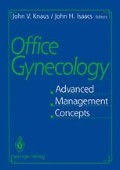Abstract
Few things cause greater concern to a woman of reproductive age than the cessation of her regular monthly menstrual period. Between menarche and menopause the only physiologic causes of amenorrhea are pregnancy and lactation. Once pregnancy has been ruled out, the absence of menses for three or more of the previous cycle intervals should be considered pathologic. While the majority of patients with secondary amenorrhea have relatively simple problems that can be easily diagnosed and managed, the physician must be concerned with potential diseases and disorders that may have more serious consequences for the patient. Amenorrhea is a symptom and not a diagnosis in itself. Non-physiologic amenorrhea is estimated to occur in 5% of women of reproductive age. In two-thirds of women menses occur at intervals of 28 ±3 days, with a normal range of 18 to 40 days.1 Oligomenorrhea of greater, than 40 days should be treated with the same significance as secondary amenorrhea; it indicates failure of the hypothalamic-pituitary-ovarian axis to induce cyclic changes in the endometrium that normally result in regular menses. Amenorrhea may also result from failure of the end organ (endometrium) to respond or from obstruction of the outflow tract.
Access this chapter
Tax calculation will be finalised at checkout
Purchases are for personal use only
Preview
Unable to display preview. Download preview PDF.
References
Treloar AE, Boynton RE, Benn BG, et al. Variation of the human menstrual cycle through reproductive life. Int J Fert. 1975; 12: 77–126.
Knobil E. The neuroendocrine control of the menstrual cycle. Recent Prog Horm Res. 1980; 36: 53–88.
Reid RL, Van Vergt DA. Neuroendocrine events that regulate the menstrual cycle. Con-temp OB/GYN. 1987; 28: 147–155.
Gindoff PR, Ferin M. Brain opioid peptides and menstrual cyclicity. Semin Reprod Endo-crin. 1987; 5: 125–133.
Yen SSC. Chronic anovulation due to CNS- Hypothalamic-Pituitary dysfunction. In: Yen SSC, Jaffee RB, eds. Reproductive Endocrinology. Philadelphia; Pa: WB Saunders Company; 1991: 631–688.
Yen SSC. The human menstrual cycle: neuroendocrine regulation. In: Yen SSC, Jaffee RB, eds. Reproductive Endocrinology. Philadelphia; Pa: WB Saunders Company; 1991: 273–308.
Speroff L, Glass RH, Kase NG. Regulation of the menstrual cycle. In: Speroff L, Glass RH, Kase NG, eds. Clinical Gynecologic Endocrinology and Infertility. Baltimore; Md: Williams & Wilkins Co; 1983: 75–100.
Strauss JF, Gurpide E. The endometrium: regulation and dysfunction. In: Yen SSC, Jaffee RB, eds. Reproductive Endocrinology. Philadelphia; Pa: WB Saunders Company, 1991: 309–356.
American College of Obstetricians and Gynecologists: Amenorrhea (ACOG Technical Bulletin 128). Washington DC, 1989.
March CM. Intrauterine and cervical pathology. In: Buttrum VC, Reiter RC, eds. Surgical Treatment of the Infertile Female. Baltimore; Md: Williams & Wilkins Co; 1985: 249–287.
Jacobs HS, Knuth UA, Hull MGR, et al. Post-pill amenorrhea: cause or coincidence? Br Med J. 1977;ii:940–942.
Coulam CB. Premature gonadal failure. In: Wallach EE, Kempers RD, eds. Modern Trends in Infertility and Conception Control. Chicago: Year Book Publishers; 1985: 84–94.
Coulam CB. Autoimmune ovarian failure. Semin Reprod Endocrin. 1983; 1: 161–167.
Yamamora DLR, Reid RL. Psychological stress and the reproductive system. Semin Reprod Endocrin. 1990; 8: 65–73.
Fayez JA, Mutie G, Schneider PJ. The diagnostic value of hysterosalpingography and hysteroscopy in infertility investigation. Am J Obstet Gynecol. 1987; 156: 558–560.
Thomas R, Reid RL. Thyroid disease and reproductive dysfunction: a review. Obstet Gynecol. 1987; 70: 789–798.
Molitch ME. Management of prolactinomas. Ann Rev Med. 1989; 40: 225–232.
Averette HE, Boike GM, Jarrell MA. Effects of cancer chemotherapy on gonadal function and reproductive capacity. CA. 1990; 40: 199–209.
Maxson WS, Wentz AC. The gonadotropin resistant ovary syndrome. Semin Reprod Endo-crin. 1983; 1: 147–160.
Ho PC, Tang GWK, Fu K, et al. Immunologic studies in patients with premature ovarian failure. Obstet Gynecol. 1988; 71: 622–626.
Kazer RR, Rebar RW. Polycystic ovary syndrome. In: Sciarra JJ, ed. Gynecology and Obstetrics. Philadelphia; Pa: Harper & Row, Publishers; 1988: 1–10.
March CM. Hysteroscopy. J Reprod Med. 1992; 37: 293–312.
Friedman A, DeFazio J, DeCherney A. Severe obstetric complications after aggressive treatment of Asherman syndrome. Obstet Gynecol. 1986; 67: 864–867.
Gambreil RD Jr. Prevention of endometrial cancer with progestins. Maturitas. 1986; 8: 159–168.
Kreiner D, Droesch K, Navot D, et al. Spontaneous and pharmacologically induced remission in patients with premature ovarian failure. Obstet Gynecol. 1988; 72: 926–928.
Frisch RE. Food intake, fatness, and reproductive ability. In: Vigersky RA, ed. Anorexia Nervosa. New York: Raven Press; 1977: 149–160.
American College of Obstetrician and Gynecologists. Medical Induction of Ovulation (ACOG Technical Bulletin 120 ). Washington, DC; 1988.
Vance ML, Thorner MO. Prolactinomas. In: Molitch, ed. Pituitary Tumors: Diagnosis and Management. Endocrinology and Metabolism Clinics of North America. 1987; 16: 731–753.
Klibanski A, Biller BMK, Rosenthal DI, et al. Effects of prolactin and estrogen deficiency in amenorrheic bone loss. J Clin Endocrinol Metab. 1988; 67: 124–130.
American College of Obstetricians and Gynecologists. Evaluation and Treatment of Hirsute Women (ACOG Technical Bulletin 103 ). Washington, DC; 1987.
Filicori M, Campaniello E, Michaelacci L, et al. Gonadotropin-releasing hormone (GnRH) analog suppression renders polycystic ovarian disease patients more susceptible to ovulation induction with pulsatile GnRH. J Clin Endocrinol Metab. 1988; 66: 327–333.
Greenblatt E, Casper RF. Endocrine changes after laparoscopic ovarian cautery in polycystic ovarian syndrome. Am J Obstet Gynecol. 1987; 156: 279–285.
Editor information
Editors and Affiliations
Rights and permissions
Copyright information
© 1993 Springer-Verlag New York, Inc.
About this chapter
Cite this chapter
Hoxsey, R.J. (1993). Secondary Amenorrhea. In: Knaus, J.V., Isaacs, J.H. (eds) Office Gynecology. Springer, New York, NY. https://doi.org/10.1007/978-1-4612-4340-3_6
Download citation
DOI: https://doi.org/10.1007/978-1-4612-4340-3_6
Publisher Name: Springer, New York, NY
Print ISBN: 978-1-4612-8740-7
Online ISBN: 978-1-4612-4340-3
eBook Packages: Springer Book Archive

